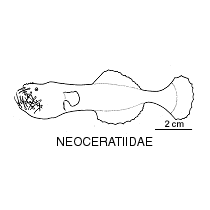- Classification
- ACTINOPTERYGII
- LOPHIIFORMES
- NEOCERATIIDAE
-
Fish Classification
-
Class
ACTINOPTERYGII Ray-finned fishes -
Order
LOPHIIFORMES Anglerfishes -
Family
NEOCERATIIDAE Toothed Seadevils -
Genera
Neoceratias(1)
Family NEOCERATIIDAE
More Info
|
Family Taxonomy |
A monotypic family (contains a single species). |
|
Family Distribution |
Found worldwide in all major oceans, inhabiting meso- and bathypelagic waters. |
|
Family Description |
Females - body slender, elongate, somewhat compressed, head short, eyes minute, poorly developed, olfactory organs degenerate, nostrils absent; mouth large, extending well beyond eye; teeth in jaws short, immobile, widely spaced; outer margins of jaws with conical protruberances bearing 2-3 series of long hinged teeth with hooked tips. No bioluminescent luring apparatus, modified first dorsal spine absent, soft dorsal and anal fins moderate, not far posterior on body; pelvic fins absent. Skin naked. Males - smaller than and parasitic on females; eyes and olfactory organs poorly developed. Premaxilla with 2 teeth, lower denticular with three hooked projections, upper denticular teeth absent. Skin naked. |
|
Family Size |
Females to 108.5 mm SL, males to 18 mm SL. |
|
Family Feeding |
Unknown, but possibly feed on by snagging prey items with the long, hooked teeth outside their jaws. |
|
Family Reproduction |
Reproduction is oviparous, and eggs and larvae are pelagic. Larvae are elongate, slender, with the skin only slightly inflated; rudimentary illicium protrudes from snout tip; pectoral fins small, pelvic fins absent. Larvae begin metamorphosis at 8-10 mm SL. |
|
Family Commercial |
Of no commercial importance. |
|
Family Conservation |
None. |
|
Author |
Dianne J. Bray |
References
Bertelsen, E. 1951. The ceratioid fishes. Ontogeny, taxonomy, distribution and biology. Dana Rept. 39, 276 pp.
Bertelsen, E., T.W. Pietsch & R.J. Lavenberg. 1981. Ceratioid anglerfishes of the family Gigantactinidae: Morphology, systematics, and distribution. Nat. Hist. Mus. L. A. Co., Contri. Sci. 332, vi + 74 pp.
Bertelsen, E. 1984. Ceratioidei: Development and relationships. pp. 325-334, In Moser, H.G., W.J. Richards, D.M. Cohen, M.P. Fahay, A.W. Kendall, Jr. & S.L. Richardson (eds). Ontogeny and Systematics of Fishes. Spec. Publ. No. 1, Amer. Soc. Ichthy. Herpet. 760 pp.
Munk, O. 2000. Histology of the fusion area between the parasitic male and the female in the deep-sea anglerfish Neoceratias spinifer Pappenheim, 1914 (Teleostei, Ceratioidei). Acta Zool. Stockholm 81(4): 315-324.
Pietsch, T.W. 1999. Neoceratiidae: Neoceratiid anglerfishes (deepsea anglerfishes), p. 2027, In Carpenter, K.E. & V.H. Niem. Species identification guide for fisheries purposes. The living marine resources of the western central Pacific. Batoid fishes, chimeras and bony fishes. Part 1 (Elopidae to Linophrynidae). FAO, Rome.
Pietsch, T. W. 2005. Dimorphism, parasitism, and sex revisited: modes of reproduction among deep-sea ceratioid anglerfishes (Teleostei: Lophiiformes). Ichthyol. Res. 52: 207-236.
Pietsch, T.W. 2005. Neoceratiidae. Neoceratias spinifer. Needlebeard Seadevils. Version 06 November 2005 (under construction). http://tolweb.org/Neoceratias_spinifer/22002/2005.11.06 in The Tree of Life Web Project, http://tolweb.org/
Pietsch, T.W. 2009. Oceanic Anglerfishes: Extraordinary Diversity in the Deep Sea. University of California Press, 576 pp.



